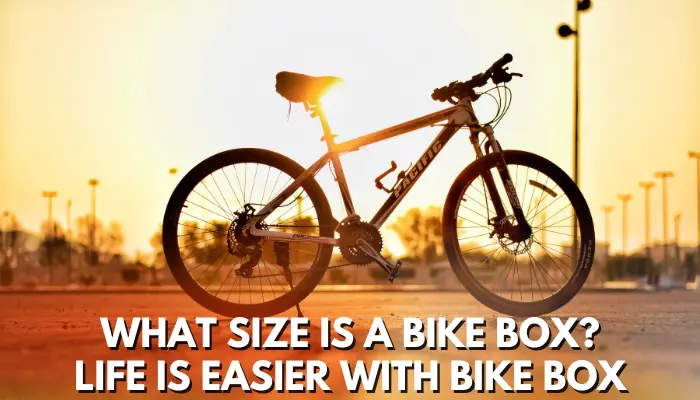Life is Easier with Bike Box! What Size Is a Bike Box?

Can you ship your bike in a proper box, just like any other product? All you have to do is to get the correct answer of what size a bike box can fit your bike. Don’t worry; you are at the right place.
Table of Contents
Short Answer
What size a bike box is? The answer to this question is the average size of the bike box is 43 x11x32, along with the other bigger size of the bike box, which is 53x29x9 or 54x28x8, respectively.
This article will provide a detailed understanding of bike box size, dimensions, and methods of how to fit a bike in a box, along with the shipping guidelines. You will get everything in one place.
What Size a Bike Box Is?
The average size of the bike box is 43 x 11 x 32 inches; the size acceptable internationally is 130 inches. But there are big boxes with bigger sizes and dimensions because of the size of the bike. Bike boxes are usually similar to the TV screen in a flat or rectangular shape. Bike boxes are mostly cardboard; you can get them from any shipping industry.
Different Sizes of the Bike Boxes:
There are different sizes besides the standard size that you can also find in the market. They are as follows;
- 47x11x32 inches (120 x 28 x 82cm)
- 51x11x32 inches (130 x 28 x 82cm)
- 53x29x9 inches (134 x 73 x 22cm)
- 54x28x8 inches (137 x 71 x 20cm)
- 55x11x32 inches (140 x 28 x 82cm)
Why is a Bike Box Size Important?
The most challenging situation is to pack your bike in an appropriate size box that can easily fit it in with minimal damage. You need to maintain the rules set by the airlines or even trains with too heavy sizes like EVOC or hard case isn’t acceptable.
As long as the cardboard size is concerning, it must also be upright to avoid extra billing. Overall, the more the bike size, the more size the bike box is required.
Average Weight of a Bike Box:
Regarding the weight of the bike box, the average weight is 2kgs, which is 4 pounds. That is the weight of an empty box. You can measure the weight of the bike by the following equations:
2kg box weight + 2kg packing weight + bike weight = bike/box total weight
The bike’s frame is of aluminum or steel, so the weight of the box bike varies. The following table will give a rough idea of the weight of the bikes, which is the rough weight of the bike box.
| Type | Average Weight | Average Box Size (inches) |
| Hybrid | 25lbs (11.5kg) | 43x11x32 |
| Recumbent | 32lbs (14.5kg) | 43x11x32 |
| Beach Cruisers | 37lbs (16kg) | 43x11x32 |
| E-Bike | 50lbs (23kg) | 43x11x32 |
| BMX | 24 lbs. (11kg) | 43x11x32 |
| Road Bike | 20lbs (9kg) | 43x11x32 |
| Mountain Bike | 29lbs (13kg) | 61.81 x 12.99 x 32.68 |
| Kids Bikes | 18-26 lbs. (8-11kgs) | 43x11x32 |
Types of Bike Box:
Bike boxes are of different sizes and shapes. They vary the type of bikes they can carry. Please have a look at them.
Cardboard Bike Box:
There are two types of bike boxes. A cardboard bike is a better option for the lighter packaging option. Usually, the type of bike box has even dimensions, and the average size is 140 x 79 x 20 cm. There must be considerable minor variations, as discussed earlier. The trek bike box is an example of a cardboard bike box with 148 x 24 x 86 cm dimensions.
Hard Bike Box:
A hard bike box is suitable for longer shipment journeys. The material it consists of is a hard plastic exterior, and the interior is with soft padding. From a safety perspective, the hard bike box is very effective and can go on a long journey. It ranges from small size to extra-large.
What is the Average Cost of a Bike Box?
The range of a bike box starts from $8.33 to $80, respectively; it also depends upon the size, box requirement, and need of a customer. And the bike box is readily available at any bike shop.
US Companies that Ships the Bikes:
Companies that ship in the US are:
- Bike Flights
- Ship Bikes
The UK and European companies for shipping of bikes are:
- Bike Delivery
- Euro Sende
Rules for Bike Box Shipping Via Airlines:
To transport a bike via airline is a hectic task, and you need to fulfill all the requirements of the airlines before the transportation. Following are the standard rules of the airlines for bike boxes:
- However, the general rule for the bike box is usually similar, which is 62 inches in height, width, and length.
- The weight of the bike is also considered during the transportation of it. Generally, weight under 50 or 50 pounds is acceptable for the airlines.
- If, in any case, your bike is over the limit in size like the road bikes; then the airline will charge you approximately 75$ to 200$
- Interestingly, AOPHIRE makes a bag-type box of 26 inches which is more of a duffle bag. So you can carry your bike in it, and you don’t have to take it from airport baggage areas.
- Non-flatted tires, no pedals, and twisted handlebars with removing the rear wheel are some bike rules for shipping.
Standard Charges for Bike Shipping Airlines:
Following are the international airlines and their charges are according to them. The following table will give you a better understanding of what size a bike box is suitable to ship according to your and the airline’s needs.
| Airlines | Bike Charges in USD | Max Weight |
| Air France | $75-150 USD depending on dest. | 23 kg |
| Aero–Mexico | $75 USD and $150 USD Intern. | 32 kg |
| Air Canada | $50 | 32 kg |
| American Airlines | Standard checked bag fees | 23 kg |
| Alaska Airlines | Standard checked bag fees | Waived |
| Allegiant Airlines | Standard checked bag fees | 18 kg |
| Emirates | Standard checked bag fees | 20-50 kg |
| British Airways | Standard checked bag fees | 23 kg |
| Delta Airlines | Standard checked bag fees | 23 kg |
| Frontier Airlines | $75 | 45 kg |
| Hawaiian Airlines | $35-$150 | 23 kg |
| JetBlue | Standard bag fee + $100 USD | 45 kg |
| Lufthansa | Changes depending on dest. | 32 kg |
| Spirit | $75 | Waived |
| Qantas | Standard checked bag fees | 23 kg |
| United Airlines | Standard checked bag fees | 23-32 kg |
| Southwest | $75 | 23 kg |
| WestJet | Standard Bag Fees + $50 Handling Fee | 45 kg |
| Virgin Atlantic | Standard checked bag fees | 23 kg |
Avoid Oversize and Overweight Fees:
It is better to avoid the oversize and weight fees if you can. Here are a few tips that you can avoid and save your money:
Hard-Sided Bike Case:
These bike cases are too heavy, and usually, they cost you more dollars than you have already spent.
Go for Extra Baggage:
In most airlines, you can ask for extra baggage to help you divide the components and save the fees.
Don’t Bring Bike Bags:
A bike bag usually costs you for being overweight, no matter how much you divide. Sometimes it costs you 200$. Say goodbye to the bike bags.
Divide The Stuff into Two Bags:
If you still carry bags, dividing the elements into two is better. So that you can have a light bag within the safe limit of the bags, the bike’s frame can be fit in frame bags.
Get Your Bike Ready for Shipping:
The following are the steps you need to take to prepare your bike for shipping;
Start with Pedals:
Remove the pedal with wrenches, make it to the left one clockwise, and reverse threading. Furthermore, for the right pedal, turn it counterclockwise and place it in bags.
Time to Take Off the Wheels:
With the help of brake calipers, take off the wheel carefully. Use brake pad spacer for disc brake bikes and lose them.
Time for Disc Rotor:
Only do it if you have a disc brake. Just take the discs off the wheel and place them in the bag.
Remove the attachments:
Moreover, please remove the accessories like frame bags, fenders, mini pumps, and GPS trackers and put them in a bag with the help of bottle cages.
Remove the Handlebars:
Mark the position of a handlebar with a marker, and then also mark the areas where you will reattach the handlebars and take them off by the stem. Do not remove the stem because the head tube may replace the compression.
Remove the Seat Post:
To remove the seat post, mark the height with tape. Check the collar to see if it is tight.
Remove The Derailleur:
Just take it off and place the derailleur in a box.
Foam Tubing:
With the help of foam tubing, cover the frame and fork. Zip ties are suitable for placing the foam in one place. The same goes for handlebars, brake levers, derailleur, seat posts, and shift levers.
Use of Plastic Spacers:
After foam tubing, use a plastic spacer to cover the fork and frame. Spacers are also available online, or you can DIY with PVC. Place them with dropouts and a fork.
Look for an Accessory Bag:
Check for the bags and put them assembly tools, disc rotors, and bottle cages, and try to put them in one.
FAQs:
Can I take an E-Bike with me on the Plane?
No airline will allow you to take a lithium battery over 100Wh; usually, most electric bikes have a battery of more than the given limit. You can ask different airlines if they have any exceptions. But generally, you cannot take an E-Bike on the plane.
What Do You Mean by Green Bike Box?
It is also known as bike turn boxes. They are at intersections, and it is considered safe place for bikers or cyclists to change tracks easily without crossing the vehicle traffic.
What is the Least Expensive Cost of Shipping a Bike?
The USPS is the world-known company to ship a bike at the cheapest rate. Other private companies charge a little more than that, along with the additional fees. Moreover, correctly label your bike before sending it to the shipping company.
Conclusion:
There is nothing new about packing your bike and going for a trip, shipping, or selling purposes; everything is possible in this era. The more technology you will have; the more ways you will get to deal with this technology. Hopefully, this article fulfills all the essential information to understand what size a bike box is?
If you plan to transport your bike via airline, there are proper guidelines you need to follow, and if you are unavailable, other options are also available. Make sure to correctly follow all the rules and regulations of the shipping company, keep in mind the budget you can afford, and most importantly, follow each step of packing.
